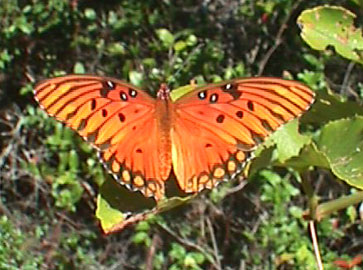 Family: Nymphalidae
Family: NymphalidaeSubfamily: Heliconiinae
 Family: Nymphalidae
Family: Nymphalidae
Subfamily: Heliconiinae
The Gulf Fritillary, although it is one of Florida's three Longwing (heliconian)
butterflies, it is a bit different from the Julia and the Zebra. It feeds only on
nectar, not on pollen as the zebra longwing. However, scientifically, it's still
considered a longwing and not a true fritillary. True frittilaries (which are
relatives to the longwings), are also orange and have silver spots on the underside of
their hindwings, but have more rounded forewings, and a more compact appearance.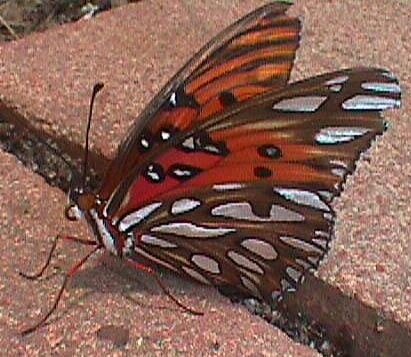
The upperside of the Gulf Fritillary is rich orange in the male and a slightly duller brown in the female, she is also a little larger. Frits are beautifully patterned on the underside, with shining silver spots across wings and a rich rose patch at the base of the forewing. This is one of the most common butterflies in Florida. Because it's larvae feed on passionvine, the adults are presumed to be distasteful to birds.
The species cannot survive freezing temperatures at any stage in its life. In late August, September,and early October, huge numbers of Gulf Frits fly into Florida from other parts of the eastern United States. It flies all year in southern Florida, and recolonizes here, in northern Florida after cold winters. It's habitat is much the same as that of the Zebra Longwing: woodland edges, city gardens, and open, brushy fields where the adults visit Lantana, Penta, and Coneflowers.
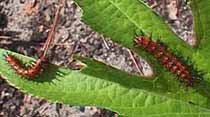 The caterpillar is orange with four rows
of black spines along it's body, that are
The caterpillar is orange with four rows
of black spines along it's body, that are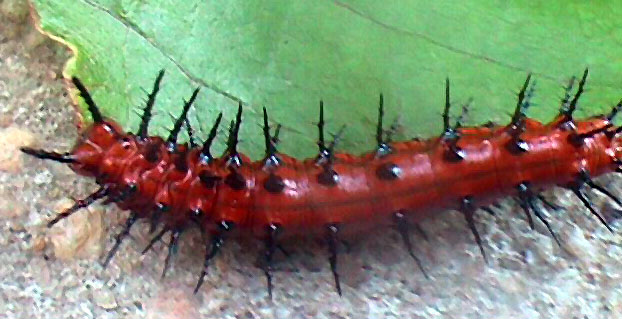 harmless to humans. They
feed on many varieties of passionvine, but seem to prefer the Maypops (P. incarnata).
Florida Butterfly Gardening, by Marc and Maria Minno, say they will eat
Corky-Stemmed Passionflower (P. suberosa), Yellow Passionflower (P. lutea),
and Incense Passionflower (P. incense), as well as the Maypops, but larvae do
poorly on Red Passionflower (P. coccinea) and Purple Granadilla (P. edulis).
The egg is deposited, one at a time on the tips of a tendril (to protect it from
ants) of the passionvine.
harmless to humans. They
feed on many varieties of passionvine, but seem to prefer the Maypops (P. incarnata).
Florida Butterfly Gardening, by Marc and Maria Minno, say they will eat
Corky-Stemmed Passionflower (P. suberosa), Yellow Passionflower (P. lutea),
and Incense Passionflower (P. incense), as well as the Maypops, but larvae do
poorly on Red Passionflower (P. coccinea) and Purple Granadilla (P. edulis).
The egg is deposited, one at a time on the tips of a tendril (to protect it from
ants) of the passionvine. 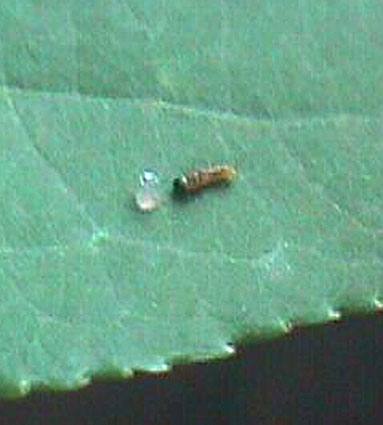
Each egg is strikingly sculpted with ribs. A newly hatched caterpillar will, first,
eat the shell of the egg before munching on the leaf. When it is finished feeding,
the cat makes a silk pad on a stem, 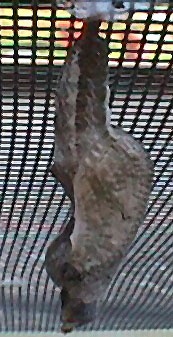 attaches its rear end to it, and hands head
down in a "J" position. The head area swells with fluid, and soon the skin
splits and rolls back. About ten days after it forms the chrysalis, the new, adult
Gulf Fritillary butterfly splits its pupal shell and emerges.
attaches its rear end to it, and hands head
down in a "J" position. The head area swells with fluid, and soon the skin
splits and rolls back. About ten days after it forms the chrysalis, the new, adult
Gulf Fritillary butterfly splits its pupal shell and emerges.
Freshly hatched cat and egg